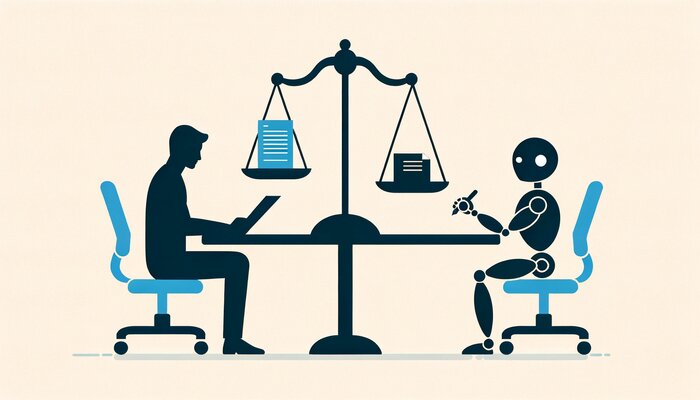
The rise of AI tools like ChatGPT has many technical writers feeling uneasy about their job security.
Headlines warn that robots are coming for a lot of jobs, especially professions involving writing and content creation. With AI assistants now able to generate coherent paragraphs and even full articles at the click of a button, some may wonder if the days of human technical writers are numbered. But while it’s true that AIs cause a disruption in our field, it does not spell doom. There are still many things that only an experienced technical writer can provide that sets them apart from even the most advanced AI available today. By understanding where we provide value compared to current AI capabilities, we can take proactive steps to evolve our skills for the future.
Let’s muse together over what these AI writing assistants can and can’t do well and ponder our thoughts on why we, technical writers, can still feel secure even if the age of artificial intelligence is stepping on our toes.
What AI Assistants Can Do
There is no doubt that AI assistants are, in general, quite capable of working with textual content in a lot of different ways, from generating to even editing. Let’s try to highlight some of the most popular uses of chatbots and look at which of their abilities are leveraged most frequently.
Generate coherent text on demand
One major capability of such AI writing tools, as ChatGPT or Claude.ai, is the ability to generate coherent text on demand on nearly any topic because they’ve been trained on massive volumes of text data, allowing them to develop a strong grasp of human language. When prompted with a topic and some basic context, they can produce multi-paragraph blocks of text that are reasonably coherent and grammatically correct. For example, we can ask it to draft a user guide for a new software feature – the feature must be explained to the chatbot first – and it will synthesize its training data and combine it with the provided information to fulfill the request. The output won’t be perfect, but it will be a decent first draft. Or, if we need to do a quick research on something, we can ask the questions to our AI helpers, too, and they would provide us with a brief answer covering the most important information.
This on-demand content generation is possible for both technical and common topics, making AI a versatile writing support tool. Though, you still need to proofread everything your AIs say since sometimes they may rely on incorrect or outdated information. Or be, as the developers say, hallucinating: generating a coherent but totally inaccurate response.
Edit content
Some AI writing assistants can generate, edit, and improve the existing text. While they are limited in its understanding of intent and strategy, they can still take your draft document and revise it to be more concise, rearrange structure for clarity, adapt text for different audiences, making content more beginner-friendly or formal as needed. This allows us, human technical writers, to focus our efforts on broader messaging while leveraging AI for lower-level refinements and adaptations.
And then, we can ask AI to show us the list of changes they made to the text and look into it to get a better understanding of how we ourselves can improve our writing skills.
Analyze data and documents to pull out key facts and insights
AI tools have become adept at analyzing content to pull out key information. You can upload large volumes of data, documents, and other content to them, and they will identify important facts, concepts, and insights. They can also compare multiple sources on the same topic and surface relevant facts and statistics.
This makes AI assistants a potentially useful aid for technical writers dealing with lots of research materials and information. The ability to quickly extract key insights saves writers time and helps shape content strategy.
Automate repetitive writing tasks like compiling reports
AI tools have the potential to automate many repetitive writing tasks that have traditionally required a lot of monotonous manual effort from technical writers. A prime example is report writing and compilation, or tasks like aggregating data from various sources, generating tables and graphs, and populating report templates with text. Tools can do all this and greatly reduce the rote writing tasks needed each cycle. We just have to proofread the result.
This allows technical writers to focus their efforts on tasks of higher value, requiring human judgment, creativity, and strategic thinking.
Produce first drafts of content that humans can edit
Perhaps the most widely applicable use of AI writing assistants is to generate initial drafts of content that human writers can then review, refine, and edit. Tools like ChatGPT allow technical writers to get a head start on writing projects by providing foundational text to build upon. The AI-generated draft provides the basic framework of information, which writers can then tweak to fit the target audience, brand voice, tone, and messaging goals. Having a complete first draft from the AI allows the human writer to focus their time and energy on the highest-value task of enhancing and perfecting the content. And because AI capabilities are still limited in areas like creativity and strategic messaging, human oversight remains essential for producing polished content. By partnering with AI as a “first draft machine,” technical writers can become more productive, efficient, and strategic in how they allocate their time and effort. Yet, to ensure that the content not only sounds good but also provides a great user experience, adhering to UX writing best practices is key.
What AI Assistants Can’t Do Well (Yet?)
Despite the impressive capabilities of AI, there are still some critical elements of human writing that advanced algorithms struggle to master.
Understand nuance, empathy, creativity needed for great writing
Well, this is what sets great writing apart from merely adequate text. This is what makes our texts shine, be they common or technical, and what only humans are capable of.
While AI-produced content is grammatically correct and consistent, it lacks the flair, wit, and emotional resonance that connects with readers. Without human guidance, AI can’t write with an authentic “voice” or inject nuanced takes, humor, and originality that make content compelling.
Get context and “big picture” needed to craft strategic messaging
Where human technical writers can craft strategic messaging tied to goals, AI lacks the broader context and “big picture” view. It can generate text around our prompts, but it can not take a step back, look at the pile of ideas and excerpts, and tie concepts together in a meaningful way. They can not understand intent or muse upon it; that’s why they can’t give advice on positioning, persuasive messaging, or impact the way an expert writer can.
Know your brand voice, guidelines, audience like an expert writer would
While we develop expertise by working closely within a discipline and internalizing its intricacies, such as guidelines, audiences, or domains, an AI assistant would need to be extensively trained and have constant human guidance to at least try to match that depth of insider knowledge.
It cannot intuitively write in your company’s distinct voice or tailor content to your readers like someone embedded within your organization.

How Technical Writers Can Stay Relevant
So, what can we draw from the information above? Well, we’d say that we can actually enhance rather than replace our uniquely human writing abilities by becoming power users of AI as a collaboration tool.
Embrace AI as a Collaboration Tool
Using AI can augment our productivity. We can use AI capabilities in data analysis, drafting, research, and more to free up our time for higher reasoning and creativity. AI can become an extension, allowing more bandwidth for the very human skills only we can provide.
The most empowered technical writers will be those who become power users of AI and learn how to leverage it to enhance their work rather than replace them.
Curate and Refine AI Content
While AI can produce initial text, leveraging our expertise to refine it is key to producing content that resonates.
The raw output from tools like ChatGPT will not perfectly match the desired tone and style without heavy human editing. Technical writers need to guide the AI to reshape content to truly fit the brand voice to resonate with the target audience. This requires applying our insider knowledge of guidelines, best practices, and reader perspectives.
Focus on High-Level Writing Strategy
To maintain our value as technical writers, we need to focus more on high-level writing strategy and less on low-level content execution. We should take charge of content strategy tied to business goals rather than simply executing content. We should drive the vision for how to convey complex concepts and tell compelling stories. By focusing efforts further upstream on planning and strategy, we can provide value that AI tools cannot replicate.
Become a Subject Matter Expert
The depth of knowledge needed to guide content strategy goes beyond what any AI assistant can muster without ongoing human instruction. And we should strive to master our subject to the point where we can provide strategic guidance on which topics merit content, which angles or frameworks make sense for certain subjects, and which facts or examples bring concepts to life. We should draw on this expertise to make creative content recommendations based on our unique understanding of the material and the audience.

Conclusion
Rather than dread the rise of artificial intelligence, forward-thinking technical writers should see this moment as an opportunity to elevate the uniqueness of human creativity. There is a middle way to evolve our craft: we need not see AI as a replacement, but as a collaborator freeing our minds for higher reasoning.
By embracing this technology as a useful tool rather than seeing it as an enemy, we open new frontiers for our imagination. The future of content lies not in the cold logic of machines, but in the inspiration born from the friction between human and artificial minds. We provide the spark, while AI provides the kindling. And from this hybrid fire the most enlightening stories of human experience infused with data-driven insight can emerge.
So let’s not fear, but engage and shape the potential of this technology through the lens of our humanity. If technical writers rise to this challenge, staying nimble and open-minded, our words will continue lighting the way forward.
Good luck with your technical writing!
ClickHelp Team
Author, host and deliver documentation across platforms and devices

